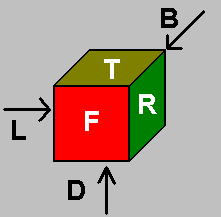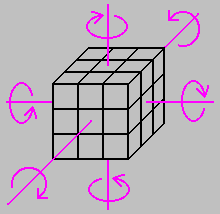Rubik's cube Notation
Throughout this section of the website, all the algorithms given use the same notation.
This notation was designed in such a way that the same algorithm can be applied to various size cubes
such as:
- the pocket cube (2x2x2)
- the original rubik's cube (3x3x3)
- rubik's revenge or Master cube (4x4x4)
- the professor (5x5x5)
- the 6x6x6 and 7x7x7 V-cubes from Panagiotis and Konstantinos Verdes
- the 9x9x9 and 11x11x11 now available from China.
But also:
- the irregular puzzles (3x3x4, 3x3x5...)
- The megaminx (dodecahedron) share some algorithms with the cubes.
- along with the gigaminx and the teraminx.
The Pyraminx (pyramid) will be treated separately.
Most algorithms are directly portable from one cube size to the other. Some need modifications.
Here is how the notation works:
| Letter code used for each face |
Clockwise rotation |
 |
Front Face | F |  |
| Right Face | R |
| Left Face | L |
| Back Face | B |
| Down Face | D |
| Top Face | T |
Notation for the rotation type:
F Means: rotate Front face clockwise, 1 step (1/4 turn for a cube)
F2 Means: rotate Front face clockwise, 2 steps (1/2 turn for a cube)
-F Means: rotate Front face counterclocwise, 1 step (1/4 turn for a cube)
-F2 Means: rotate Front face counterclockwise, 2 steps (1/2 turn for a cube)
Note: For a cube F2 and -F2 produce the same result, but for the Megaminx they are different.
For the 4x4x4 and the 5x5x5, we need to specify how many layers we are rotating at the same time. Also, sometimes even for the 3x3x3 we may want to specify turning the 2 layers on the right 1/4 turn, instead of 1 layer on the left 1/4 turn. These operations are equivalent, except for the fact that the location of the centers have changed.
Notation for how many layers are to be turned:
2R Means turning the right 2 layers 1/4 turn clockwise
-3R Means turning the right 3 layers 1/4 turn counterclockwise (used on the 4x4x4 and above).
Home
Francais



